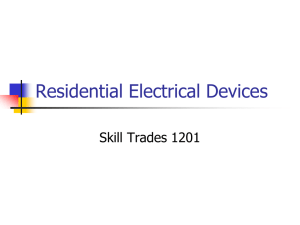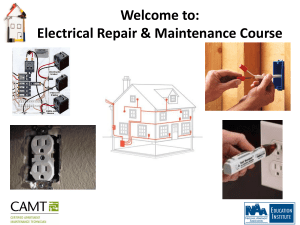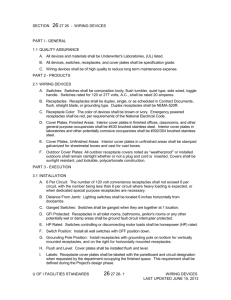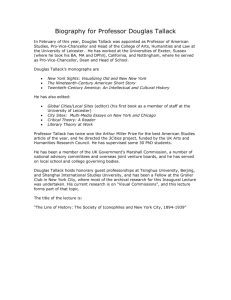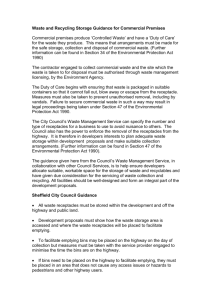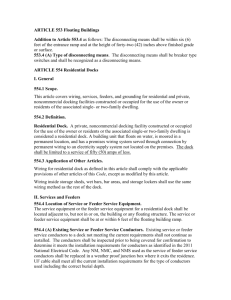California 2010 Code Links
advertisement
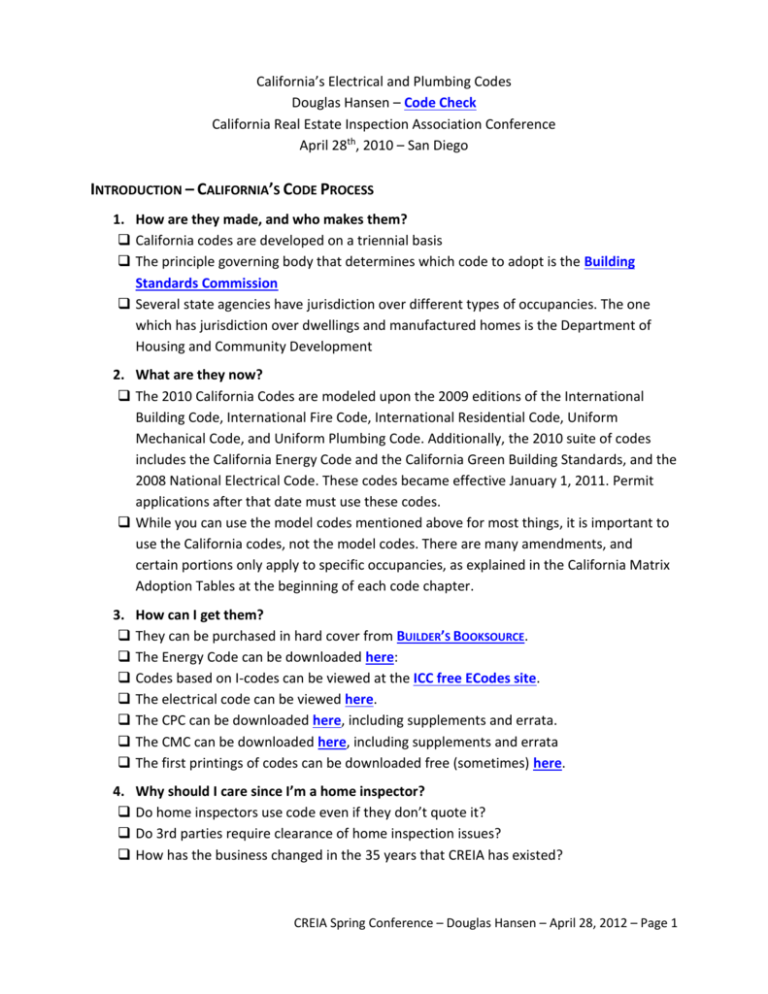
California’s Electrical and Plumbing Codes Douglas Hansen – Code Check California Real Estate Inspection Association Conference April 28th, 2010 – San Diego INTRODUCTION – CALIFORNIA’S CODE PROCESS 1. How are they made, and who makes them? California codes are developed on a triennial basis The principle governing body that determines which code to adopt is the Building Standards Commission Several state agencies have jurisdiction over different types of occupancies. The one which has jurisdiction over dwellings and manufactured homes is the Department of Housing and Community Development 2. What are they now? The 2010 California Codes are modeled upon the 2009 editions of the International Building Code, International Fire Code, International Residential Code, Uniform Mechanical Code, and Uniform Plumbing Code. Additionally, the 2010 suite of codes includes the California Energy Code and the California Green Building Standards, and the 2008 National Electrical Code. These codes became effective January 1, 2011. Permit applications after that date must use these codes. While you can use the model codes mentioned above for most things, it is important to use the California codes, not the model codes. There are many amendments, and certain portions only apply to specific occupancies, as explained in the California Matrix Adoption Tables at the beginning of each code chapter. 3. How can I get them? They can be purchased in hard cover from BUILDER’S BOOKSOURCE. The Energy Code can be downloaded here: Codes based on I-codes can be viewed at the ICC free ECodes site. The electrical code can be viewed here. The CPC can be downloaded here, including supplements and errata. The CMC can be downloaded here, including supplements and errata The first printings of codes can be downloaded free (sometimes) here. 4. Why should I care since I’m a home inspector? Do home inspectors use code even if they don’t quote it? Do 3rd parties require clearance of home inspection issues? How has the business changed in the 35 years that CREIA has existed? CREIA Spring Conference – Douglas Hansen – April 28, 2012 – Page 1 5. Does the state amend the model codes? Each agency has amendments for the occupancies which they regulate. Only the State Fire Marshal (SFM) and Department of Housing & Community Development make amendments affecting single family homes 6. Are there local amendments? In theory, local amendments can only be more restrictive, and must be based upon topographic, geologic, or climatic reasons. San Francisco does not use the CRC. Most local amendments are available on line as municipal ordinances Los Angeles amendments to the CRC are here. 7. When is the next round of changes? Interim supplements go into effect July 1, 2012. These primarily affect accessibility. The next complete set of codes will be the 2013 codes, effective in January, 2014. 8. What happens when two codes are in conflict? Specific rules trump general rules. The most restrictive code applies. The Mechanical Code prevails over the Plumbing Code. 9. Why two building codes? How do we know which code to use? 1- & 2-Family Dwellings and Townhouses use the CRC. All other buildings use the CBC. Buildings within the scope of the CRC use it for all nonstructural issues. Buildings within the scope of the CRC may use it for structural issues within the prescriptive limits of the CRC. Beyond those limits, they use the CBC. In some cases, the CRC is used for all of the structural issues other than the ones exceeding its limits, and in other cases all of the structural issues are done per the CBC. It is always OK to use the CBC for structural issues, except for section 2308 (conventional light-frame construction), which cannot be used for items within the scope of the CRC. 10. What are some of the main gray areas? When can a remodel be considered an alteration and when does it trigger “new construction” requirements for the entire dwelling? What happens when I want to replace the fenestration in a dwelling that does not meet current setback requirements? When does a remodeling project trigger a need for automatic fire sprinklers? When do smoke alarms require a hard-wired power source? When do carbon monoxide alarms require a hard-wired power source? What permit signoffs are needed to replace a gas-burning appliance? CREIA Spring Conference – Douglas Hansen – April 28, 2012 – Page 2 CALIFORNIA’S ELECTRICAL CODE Credits IAEI Paddy Morrissey 1. California & local amendments OSHPD amendments Seismic amendments Local amendments Examples: San Francisco, Oakland Insulation over knob & tube 2. Changes to Services & Grounding New terminology Grounding electrodes Grounding in separate buildings Intersystem bonding Connection methods & identification Cover-mounted receptacles Gas pipe bonding Services (Terminology) (230.53) Service heads suitable for wet locations (230.54) Service heads LISTED (change from “raintight”) (310.8D) Conductors listed as sunlight resistant or covered with material listed for sunlight resistance Grounding (Terminology) Ground = The earth Grounded = Connected to the earth Bonded = Connected to establish electrical continuity and conductivity Neutral Conductor = Conductor connected to neutral point of system 2011 – No more “grounding conductor” Grounding Electrodes Ufer in vertical pier Lyncole ground rods accepted 2 rods required unless resistance proven ≤25Ω CREIA Spring Conference – Douglas Hansen – April 28, 2012 – Page 3 Grounding and Bonding at Outbuildings New construction Existing buildings Intersystem Bonding Step potential and equipment protection Intersystem bond terminal kits Grounding Methods Continuity of neutral not reliant upon enclosure Identification of conductors >6 AWG Terminations 3. Panels & Overcurrent Protection Devices Location and placement Not located over steps of a stairway Repair of noncombustible surfaces Unused Openings Factory-made mounting holes acceptable Multiwire Circuits Simultaneous disconnecting means Conductor grouping AFCIs Combination versus branch-feeder Required locations Implications of expanded requirements Multiwire Circuits Testing Remodels Lighting & Appliance Panelboards Discarded terminology 42 breaker limit Class CTL panels Circuit Directories Distinct from all other circuits Not for transient conditions of occupancy Unused breakers labeled CREIA Spring Conference – Douglas Hansen – April 28, 2012 – Page 4 4. Wiring Raceways Circular raceways above roofs Above-ground conduits in wet locations Flexible metal conduit in wet locations Securing and supporting NM cable Derating in holes or in contact with insulation Securing in basements and crawlspaces Damp locations Ampacity of SER cable 5. Appliances, Receptacles and Luminaires Appliances Breakers in lieu of in-sight disconnecting means Mounting of air-conditioning disconnects Required locations of receptacles Balconies and porches Switched receptacles Definition of separate counter spaces on islands Receptacles in unfinished basements GFCI Protection Changes in UL standards Exceptions deleted / new required locations New types of receptacles Weather-resistant Tamper-resistant Outlet-type AFCIs Power-safe receptacles Luminaires Listing required Damp or wet location listing for luminaires within tub/shower footprint LED luminaires added to clothes closets CREIA Spring Conference – Douglas Hansen – April 28, 2012 – Page 5 Low Voltage Lighting Systems Listed systems Assembly of listed parts Separation from bodies of water 6. Special Equipment Pools and other bodies of water Receptacles near pools and spas Underwater junction boxes in fountains All pool motors GFCI protected Hydromassage tub bonding Hydromassage tub circuits Electric Vehicle Charging Systems Separate services and billing rates Types of charging systems Photovoltaic Systems Source and output circuits inside a building Roof-integrated systems Labeling 7. Looking ahead to the 2013 CEC (2011 NEC) Receptacles GFCI devices in a readily accessible Location GFCI required within 6 ft. of all sinks Replacement receptacles TR, WR, or AFCI as appropriate Pop-up countertop receptacles Receptacles required in foyers Receptacles on personal viewing balconies Neutrals Re-identified conductors only as supply to switch Not to be used for more than one circuit or mw circuit Switch boxes must contain a neutral CREIA Spring Conference – Douglas Hansen – April 28, 2012 – Page 6 CALIFORNIA’S PLUMBING CODE PEX No longer excluded from CPC Not allowed within 18 inches of water heater (604.11.2) PEX-AL-PEX not adopted by HCD Initial (not replacement) PEX systems require flushing procedure CPVC Used for areas with water chemistry contributing to Cu pipe failure Low VOC one-step cement required – no primer on CPVC, low VOC primer on PVC CPVC acceptable if flushed in accordance with IAPMO standards Plastics - General Replacement plastic water services require blue 18 AWG tracer wire ABS & PVC drainage limited to two stories of “residential accommodation” Lead-free piping and fixtures CPC limits pipe and fittings to 8% lead content H&S code 116875 prevails (0.25%) AB 1953 not intended to apply to fixtures and fittings for other than potable water Grey Water Systems Buildings with both potable and non-potable water require system identification Symbol of circle with slash over a glass for non-potable systems Water conservation and the Green Building Standards Faucets (sinks, lavatories, etc.) 2.2 gpm @ 60 PSI WCs 1.28 per flush Dual flush OK if effective flush volume 1.28 per ASME A112.19.2 CPC 402 Shower heads 2.5 gpm @ 80 PSI Green Building Standard requires 20% reduction in baseline water use Multiple shower heads require compliance at their combined rate Showers Min. area not applicable for 30 x 60 compartment (IPC is 25 in. & 1300 sq. in.) Curbless showers, local ordinances on high rise construction Water Heaters Size based upon first-hour rating Replacement water heaters required permits Seismic per H&S Code 19211(a) and CPC 508.2 Strapping in upper & lower thirds, 4 in. min. above controls DSA not applicable to dwellings 508.4 Pans – what about tankless water heaters? Indirect-fired water heaters CREIA Spring Conference – Douglas Hansen – April 28, 2012 – Page 7 Scald Protection Tubs 120°F Bidets 110°F Showers –120°F Gas Piping Excess flow valves Drips for other than dry gas, sediment traps for all water heaters & space heating Bonding of other than CSST per NEC Bonding of CSST with min. 6 AWG copper at point where gas enters building Shutoff valve within 6 feet of appliance (CMC 1313.4) Connector length not limited (CMC 1313.1) CALIFORNIA’S MECHANICAL CODE Propane Storage per NFPA 58 and California Fire Code Appliances not in pit, basement, or similar location unless approved means for removal of unburned gas Return Air Restoration of rules on prohibited sources Exhaust Systems Termination min. 3 ft. from other building openings (504.5) Ducts May not cut off access to any portion of crawl space (604.1) Min. 18 in. tunnel under ducts that do cut off portions of crawlspace Gas Appliance Venting Screws not to penetrate inner wall of B-vent except at appliance collar No single-wall vents in dwellings (connectors OK, not vents) (802.7.4.1) Plastic vents installed in accordance with manufacturer’s instructions (802.4.3) Primer must be contrasting color Gas Appliances Platform required for attic furnaces; access from ladder not sufficient (904.11.4) Unvented space heaters prohibited INDOOR AIR QUALITY ISSUES - ASHRAE 62.2 AND THE CALIFORNIA ENERGY CODE Whole Building Ventilation Maintain ventilation rates of ASHRAE 62.2 Table 4.1A Kitchen exhaust required Bathroom and toilet room exhaust required Green Building Standard requires humidistat control Refer to the California Energy Code Residential Compliance Manual CREIA Spring Conference – Douglas Hansen – April 28, 2012 – Page 8 CREIA Spring Conference – Douglas Hansen – April 28, 2012 – Page 9

